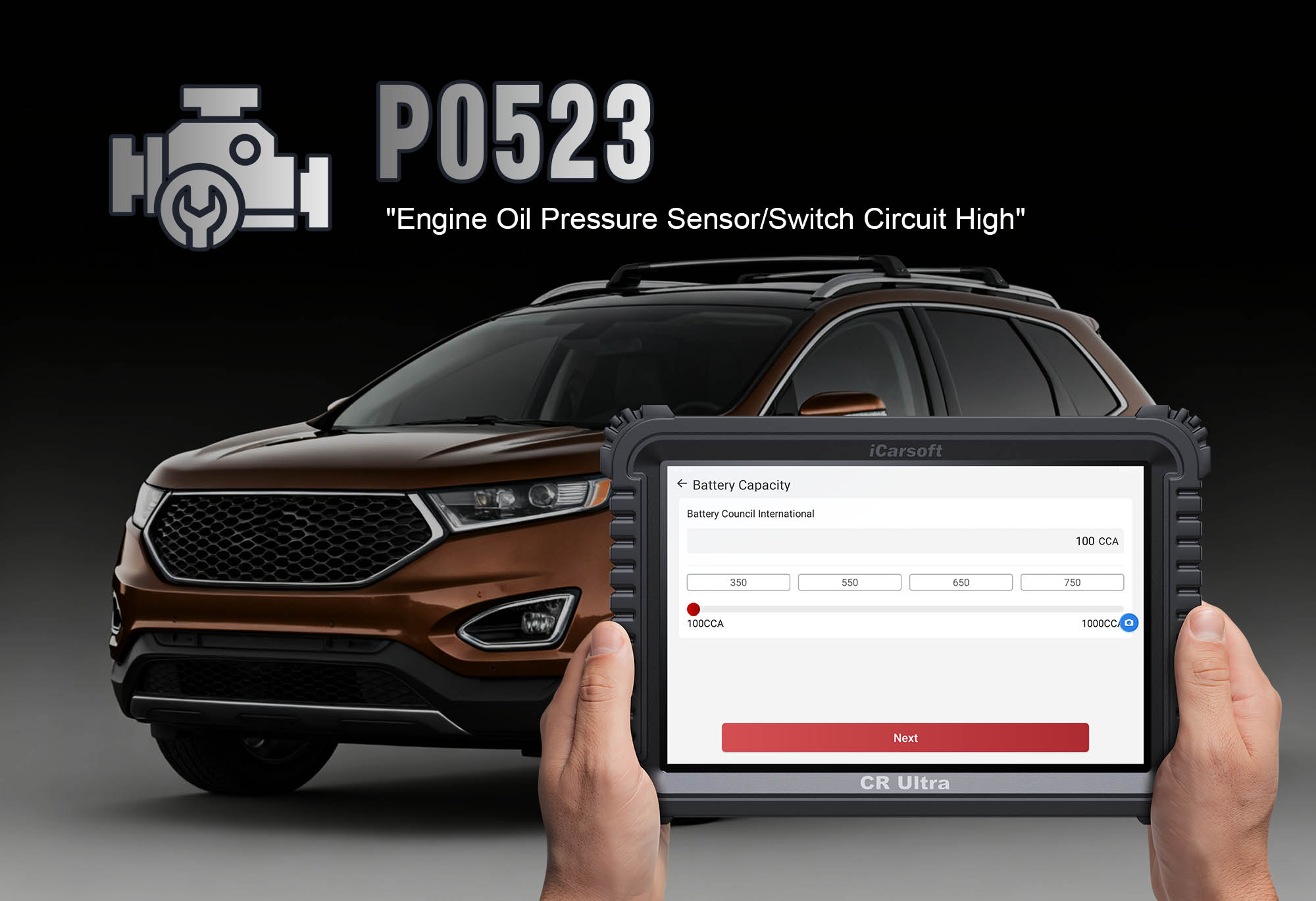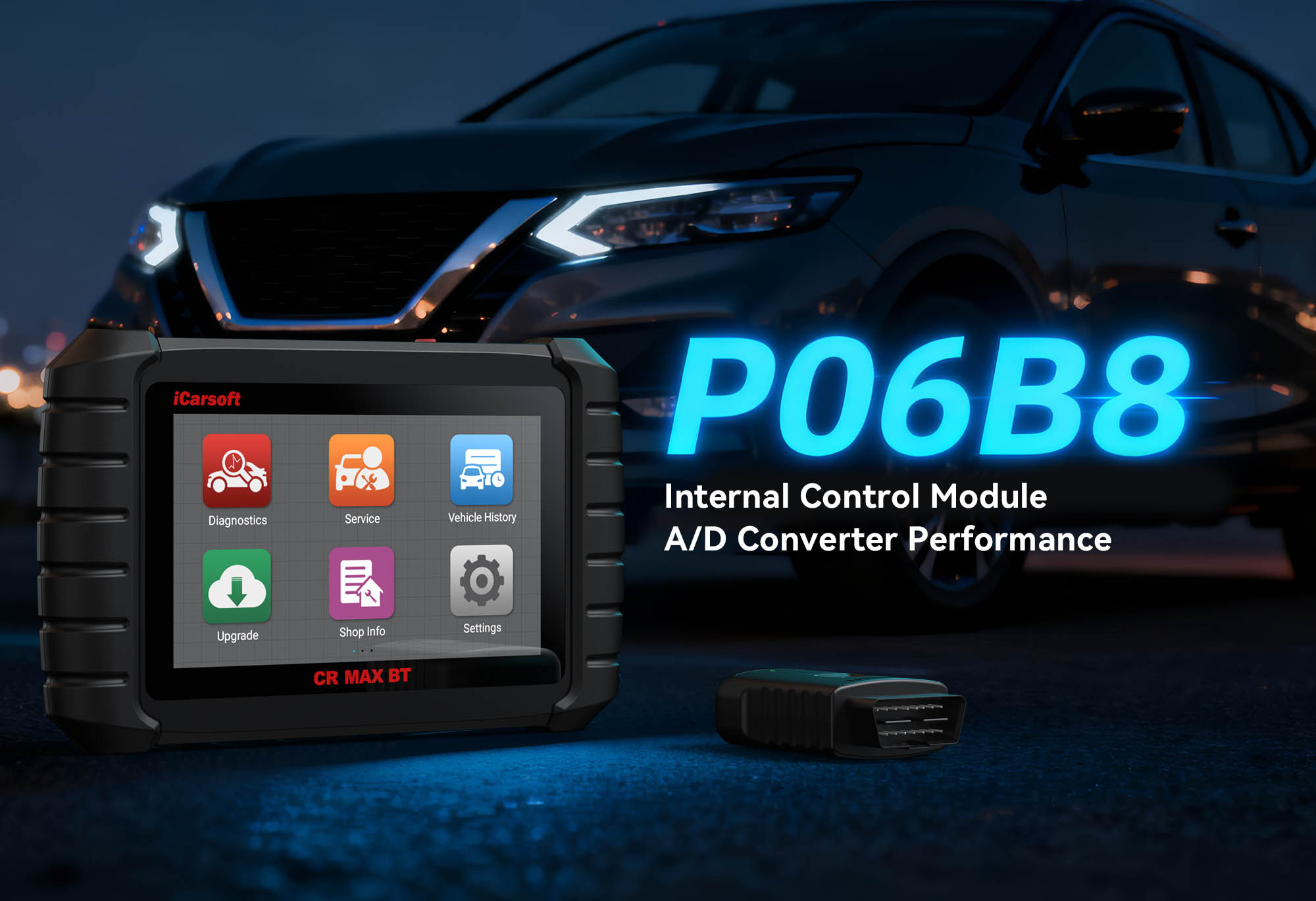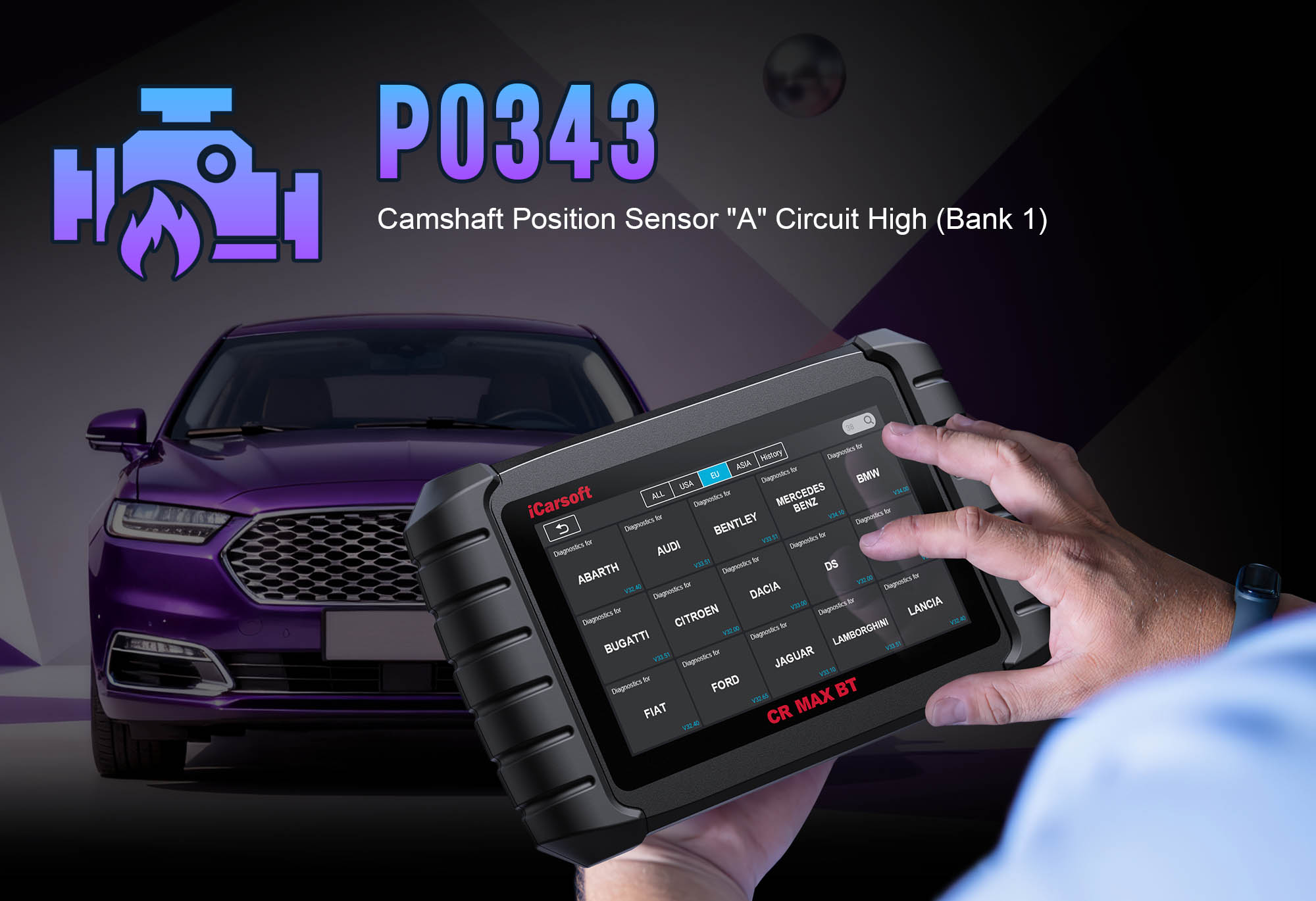P0523 Code: How to Diagnose & Fix Engine Oil Pressure Sensor High Voltage with iCarsoft CR Ultra
If your check engine light turns on and you notice an unexpected "Oil Pressure High" warning on the dashboard—especially during acceleration or when the engine is cold—a diagnostic scan will likely return P0523. This OBD-II code stands for "Engine Oil Pressure Sensor/Switch High Voltage (Circuit High Input)," meaning the Engine Control Module (ECM) is receiving an abnormally high voltage signal from the oil pressure sensor.
The engine oil pressure sensor acts as a "pressure messenger," converting mechanical oil pressure into electrical voltage signals for the ECM. Under normal conditions, voltage correlates with pressure: ~0.5V at idle (low pressure, 10–20 psi) and ~4.5V at wide-open throttle (high pressure, 50–60 psi). P0523 triggers when the sensor’s signal exceeds the ECM’s maximum threshold (typically >4.8V), which can indicate either dangerously high oil pressure (a mechanical risk) or a fault in the sensor/circuit (an electrical issue). Ignoring this code is risky: high pressure can rupture oil lines, damage seals, or overload the oil pump—leading to costly engine repairs.
Basic scanners may only flag "oil pressure sensor high voltage" but can’t tell if the problem is real pressure or a faulty sensor. The iCarsoft CR Ultra, with its advanced voltage waveform analysis, circuit integrity testing, and mechanical pressure validation, solves this. Let’s walk through how to diagnose and resolve P0523 safely and precisely.
Understanding P0523: Causes & Key Symptoms
P0523’s high voltage signal stems from two distinct categories of issues—mechanical (actual high pressure) or electrical (sensor/circuit faults)—each with unique symptoms that help narrow down the root cause.
Key Symptoms of P0523
-
Check Engine Light + "Oil Pressure High" Warning: The most critical combination, signaling potential mechanical pressure issues (not just a sensor glitch).
-
Oil Leaks or Seepage: High pressure forces oil past seals (e.g., valve cover gaskets) or cracks oil lines—look for fresh oil under the engine or on components.
-
Unusual Engine Noise (Whining/Growling): An overworked oil pump (struggling against high pressure) produces a whining sound, especially at high RPM.
-
Reduced Oil Flow: Restricted oil passages (a cause of high pressure) starve components like camshafts, leading to ticking or tapping noises.
-
Intermittent Warnings: High voltage only during cold starts or vibration points to a shorted wire or faulty sensor (not real pressure).
Common Causes of P0523
|
Cause
|
Description
|
|
Restricted Oil Passages
|
Sludge buildup, debris, or a clogged filter bypass valve blocks oil flow, causing pressure to spike and voltage to rise.
|
|
Incorrect Oil Viscosity
|
Using overly thick oil (e.g., 20W-50 instead of 5W-30) increases flow resistance, raising pressure and sensor voltage.
|
|
Faulty Oil Pressure Sensor
|
Internal short circuits or damaged diaphragms cause false high-voltage signals, even with normal pressure.
|
|
Wiring/Circuit Shorts
|
Frayed wires touching the engine’s positive terminal (or 12V source) create a short, pushing voltage to max.
|
|
Stuck Oil Pressure Relief Valve
|
The valve (which regulates pressure) gets stuck closed, causing pressure and voltage to skyrocket.
|
|
ECM Malfunction (Rare)
|
A faulty ECM misinterprets normal sensor signals as high voltage—easily ruled out with the CR Ultra.
|
Why iCarsoft CR Ultra Excels at Diagnosing P0523
The CR Ultra outperforms basic tools with features tailored to oil pressure system diagnostics—critical for distinguishing mechanical pressure issues from electrical sensor faults:
Voltage Waveform Capture
Records real-time sensor voltage patterns to identify "flatline high" (constant >4.8V = shorted sensor) or "intermittent spikes" (loose wire).
Circuit Short Detection
Measures resistance in the sensor wiring to locate shorts (e.g., wires touching the alternator’s positive terminal).
Mechanical Pressure Validation
Integrates with mechanical gauges to compare sensor voltage with actual pressure—confirms if high voltage = real high pressure.
3D Lubrication System Mapping
Displays high-res diagrams of the sensor, relief valve, and oil passages for 200+ brands (e.g., "Toyota Camry: Relief Valve = Inside Oil Pump").
Oil Viscosity Cross-Check
Matches VIN-based oil specs with sensor data to flag overly thick oil as a P0523 cause.
Sensor Simulation Test
Sends calibrated voltage to the ECM to verify module interpretation—rules out ECM malfunctions.
Step-by-Step: Diagnose P0523 with iCarsoft CR Ultra
-
Prioritize Safety: Check Oil Type & Level First
1. Oil Viscosity: Confirm you’re using the manufacturer-recommended grade (e.g., 5W-30 for modern 4-cylinders). Thick oil (15W-40) often triggers P0523 in cold weather.
2. Oil Level: Check the dipstick (engine off, 5+ minutes for drainage). Overfilling (above "MAX") increases pressure—drain excess if needed.
-
Connect the CR Ultra & Confirm the Code
1. Plug the CR Ultra into the OBD-II port (use adaptors for older models) and power on the tool.
2. Select your vehicle via Auto VIN Scan (instantly pulls specs) or manual entry.
3. Navigate to Engine > Fault Codes > Read Codes to confirm P0523. Tap Code Details for vehicle-specific insights (e.g., "Ford F-150: Check Relief Valve & Sensor Wiring").
-
Locate Key Lubrication Components
1. Go to Component Location > Engine > Lubrication System > Oil Pressure Sensor & Relief Valve.
2. Use the 3D diagram to identify:
- Oil Pressure Sensor: Typically on the engine block near the oil filter.
- Relief Valve: Inside the oil pump or main oil gallery (critical for pressure regulation).
- Sensor Wiring: Path to the ECM (check for proximity to 12V components like the alternator).
-
Analyze Live Oil Pressure Sensor Data
1. Start the engine (test cold if symptoms occur when cold) and let it warm up (5–10 minutes).
2. Navigate to Engine > Live Data > Lubrication > Oil Pressure Sensor and monitor:
- Sensor Voltage: Normal = 0.5V (idle) to 4.5V (WOT); P0523 = >4.8V.
- Constant High Voltage: Stays >4.8V across RPM = shorted sensor or real high pressure.
- Intermittent High Voltage: Spikes only when cold/vibrating = loose wire or sensor fault.
- Oil Temperature: Cold oil (>100°F) thickens temporarily—if voltage drops as oil warms, viscosity is the cause.
-
Test the Sensor Circuit for Shorts
1. Resistance Test: - Turn off the engine and disconnect the sensor connector.
- Use the CR Ultra’s multimeter to measure:
- Signal pin → chassis ground: Normal = infinite resistance (continuity = shorted wire).
- Power pin → ground (if equipped): Normal = 12V (battery voltage); >12V = faulty regulator.
2. Sensor Resistance Test: - Remove the sensor and measure internal resistance (specs: 1,000–3,000 ohms). <100 ohms = internal short (replace sensor).
3. Wiring Inspection: - Follow the 3D map to check for frayed wires near 12V components—touching parts cause shorts.
-
Validate Actual Oil Pressure (Mechanical Check)
1. Remove the oil pressure sensor and install a mechanical gauge (use the CR Ultra’s Adapter Guide for compatibility).
2. Reconnect the sensor wiring to the CR Ultra (set to "Live Monitoring Mode") and start the engine.
3. Compare readings:
- Gauge <60 psi + Voltage >4.8V: Faulty sensor (replace it).
- Gauge >70 psi + Voltage >4.8V: Real high pressure (investigate relief valve/passages).
-
Fix Mechanical Causes (If Pressure Is High)
1. Oil Viscosity Correction: Drain thick oil and refill with OEM-recommended grade (e.g., 5W-30 for Honda Civic).
2. Relief Valve Service: Locate via 3D map—clean debris or replace if stuck closed.
3. Oil Passage Cleaning: Use the CR Ultra’s Sludge Detection Tip and oil system cleaner to unclog passages.
4. Filter Replacement: Install an OEM filter (aftermarket filters may have faulty bypass valves).
-
Repair & Clear P0523
1. Fix the root cause:
- Electrical: Replace shorted sensors, splice frayed wires with heat-shrink connectors.
- Mechanical: Correct viscosity, clean/replace relief valve, unclog passages.
2. Clear the code: Navigate to Engine > Fault Codes > Clear Codes to delete P0523.
-
Validate the Repair (Safety Critical)
1. Recheck live data: Voltage stays 0.5V–4.5V (no spikes >4.8V) across all RPM.
2. Test drive 30–40 minutes (cold starts + high RPM): No "Oil Pressure High" warnings or check engine light.
3. Inspect for leaks post-drive: No new seepage = pressure is stable.
Preventing P0523 Recurrence
Use the iCarsoft CR Ultra to maintain healthy oil pressure and avoid future P0523 issues:
-
Oil Maintenance Reminders: Set Service Reminder to change oil every 5,000–7,500 miles (use VIN-recommended viscosity).
-
Sensor Health Checks: Include the oil pressure sensor in annual electrical scans—test resistance/voltage to catch early faults.
-
Relief Valve Servicing: Use Maintenance Schedule to clean the relief valve every 100,000 miles (prevents sticking).
-
Sludge Prevention: The CR Ultra’s Oil Quality Monitor alerts to degraded oil (sludge precursor)—change oil early if needed.
Conclusion
P0523’s high voltage signal is a critical warning, but the iCarsoft CR Ultra turns uncertainty into clarity by distinguishing electrical sensor faults from mechanical high pressure. Whether replacing a shorted sensor, correcting oil viscosity, or fixing a stuck relief valve, this tool ensures you address the root cause—protecting your engine from pressure-related damage like ruptured lines or seal failure.
With the CR Ultra, diagnosing "oil pressure sensor high voltage" becomes a precise, safe process—keeping your engine’s lubrication system running at optimal pressure for years of reliable performance.
FAQs About P0523 Code
Q: Can I drive with P0523?
A: Short trips (to a repair shop) may be possible, but prolonged driving risks oil line rupture, seal damage, or oil pump failure. Address P0523 within 1–2 days.
Q: How much does it cost to fix P0523?
A: $30–$100 for a sensor; $50–$150 for oil/filter changes (viscosity correction); $200–$500 for relief valve/service (mechanical issues). The CR Ultra ($200–$300) avoids costly misrepairs.
Q: Will changing oil fix P0523?
A: If thick oil is the cause, yes. But if P0523 stems from a shorted sensor or stuck relief valve, oil changes alone won’t resolve it—use the CR Ultra to confirm the root cause.
Q: Can a bad oil pump cause P0523?
A: Indirectly—if the oil pump’s relief valve is stuck closed (a common pump issue), pressure spikes, triggering P0523. The CR Ultra’s pump flow test helps identify this.





